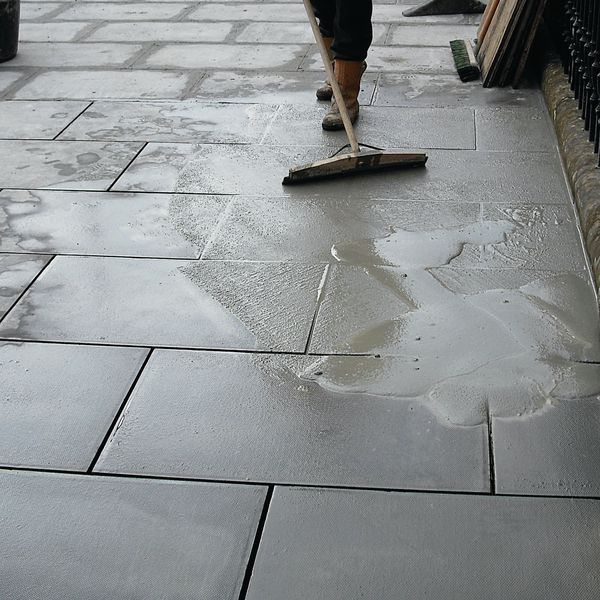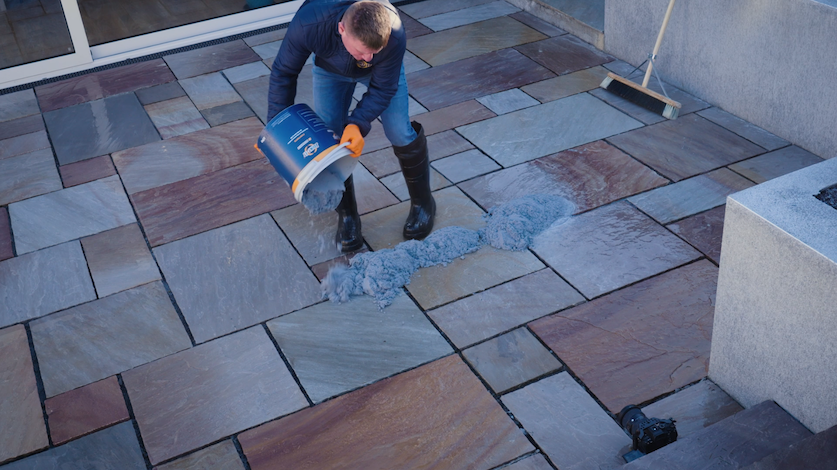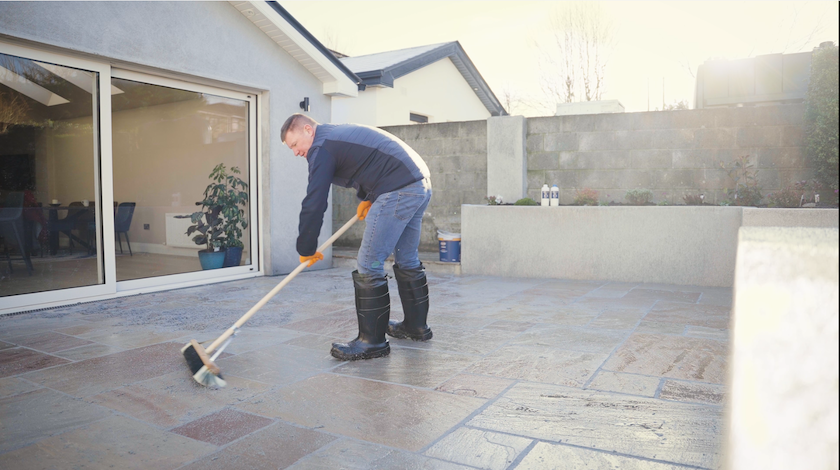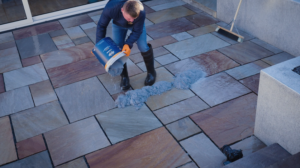A common question asked by landscapers and paving contractors is whether they can use Flowpoint in the rain. Find out from the experts about the ideal weather conditions for applying this popular flowable grout and our best-practice advice on creating long-lasting patios and pavements.
Flowpoint is a cement-based flowable grout used to fill the joints in patios, terraces and pavements. It is simple to mix and apply, and sets within as little as 15 minutes.
As the name suggests, Flowpoint is applied as a wet slurry. So there is obviously a certain amount of water involved in creating this flowable slurry. To be exact, the pre-mixed, dry Flowpoint product is added to 4.25 litres of water.
But will some extra rainwater put a dampener on your paving project?
Some good news for patio layers across Britain: the easy answer is ‘No’. A little extra rainwater during application will help to keep the pavers and joints damp.
However, it does depend on how much it is raining. Learn more about how Flowpoint should be applied and how much rainwater is ‘too much’.
How Flowpoint is applied
As a flowable grout, Flowpoint needs some extra water during application. As such, slightly damp paving surfaces are recommended. They allow the Flowpoint to be easily brushed into the paving joints where it rapidly hardens and sets.
With Flowpoint, a little extra water is essential for:
- Dampening the paving joints and surfaces – both before and during application
- Stopping grout from hardening on the surfaces
- Removing any grout residue from the pavers

Regardless of the weather, either a hosepipe (with a spray nozzle), pressure washer, washboy or Berta sponge machine is a must when applying Flowpoint. But a slightly damp day with a light misting of rain can help you get the job done.
Ideal weather conditions for applying Flowpoint
A light drizzle is an ideal weather condition for applying Flowpoint. The extra water will help to keep the area damp and stop the grout from hardening too quickly.
However, you must keep an eye on the weather.
Anything more than a light shower can be too much for the still unhardened Flowpoint to handle. Heavy showers can overwater the joints and potentially dilute and compromise the mixture. If the area is too saturated, Flowpoint can be left shallow in parts of the joints. Once it has dried, it can then cause the mortar to potentially crack and fail.
Another risk from using too much water – with any type of slurry grout – is what we call ‘picture framing’ or efflorescence stains on the joints and edges of pavers. When the jointing compound fails, salts and minerals can be drawn-up through the bedding mortar to form a white salty residue, framed around the edges.
As a rule of thumb, if the paving joints are filling up with rainwater, postpone your grouting activities for another time. You want the area to be damp, but never saturated.
What about applying Flowpoint on a hot day?
During spells of warm weather, you can still apply Flowpoint. But you will need to have that trusty hosepipe or sponge machine at hand. Always ensure the area is kept constantly damp to avoid the grout setting up home on those surfaces.
As mentioned, Flowpoint is a rapid-setting grout. On days of 20°C it will set within as little as 15 minutes. That can be enough time to squeegee the wet slurry into the paving joints, but when the temps are a little cooler you will have a little longer to do the job.
If the temperature is at or close to 30°C, do not grout your pavers. Those extra degrees centigrade will set the Flowpoint instantly.
When the forecast is pointing to it being a hot day and you need to get those pavers finished pronto, opt for grouting them either first-thing in the morning or early evening when it is much cooler.
Can Flowpoint be applied during cold weather?
Talking about temperatures, cold weather snaps are the other thing to be aware of.
Makers of the more traditional wet slurry grouts advise never to apply them during cold temperatures of less than 5°C
But Flowpoint can be used at a few notches cooler than that: 2°C or above is recommended.
Basically, you want to avoid the wet slurry from freezing. If the slurry freezes before properly setting, cracks may later form in the mortar.
Come rain or shine
In a nutshell, Flowpoint can be applied during a light shower as that extra bit of water will actually help to dampen the area. Our paving experts say a misting of the paving surfaces is ideal for keeping the area damp rather than saturated. Always have either a hosepipe set to spray, washboy or sponge machine at hand, as you will certainly need one of these for the initial and final wash-off stages.
Watch the video on how to apply Flowpoint so you can see exactly what you need to do before starting the job. It really is an easy paving grout to apply and, when applied in combination with Eco-bed bedding mortar and followed up with Pro-Prime slurry primer, the manufacturer Ultrascape says it will last beyond 40 years without needing to re-grout.









2 thoughts on “Can I use Flowpoint in the rain?”
Can flowpoint be applied to a granite set driveway on a hill? The sets are rough cut and no flat surfaces, and on a hill
Hello Scott, yes you can, Flowpoint works brilliantly on setts and cobbles – it’s a product that is specified on many major streetworks schemes across the country, you’ll see Flowpoint used a-lot in town centres with cobbles. In terms of using it on a hill, it tends to be a little more tricky and we’d recommend mixing and applying one bag at a time. Working from the bottom up, is how many customers do this. If you’d like some more detailed information, please don’t hesitate to drop us a note at orders@thepavingexperts.co.uk